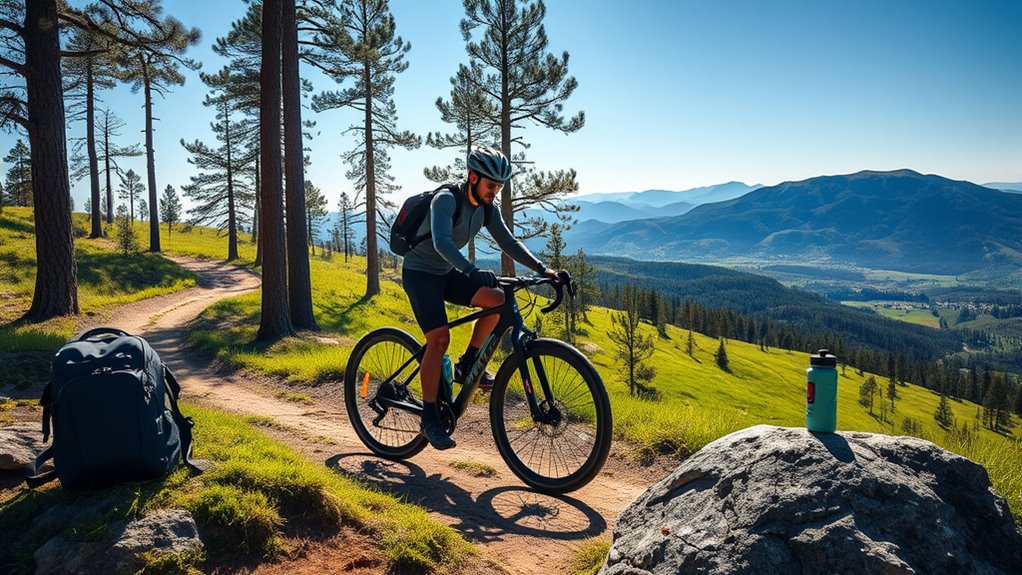To prepare for cross-country e-bike touring, choose a bike with the right motor (mid-drive or hub), sufficient battery capacity, and reliable tires suited for varied surfaces. Pack lightweight, weather-resistant gear, tools, and safety equipment, and plan routes with charging stations and rest stops. Conserve battery using efficient riding modes, maintain your bike properly, and build your physical and mental stamina. If you want detailed tips on each step, keep exploring these expert guidelines.
Key Takeaways
- Select an efficient motor type and appropriately match battery capacity to optimize range and performance for long-distance travel.
- Plan your route with charging stations, rest stops, and terrain considerations to ensure timely power top-ups and rider recovery.
- Pack lightweight, weather-resistant gear with essential tools, safety equipment, and spare parts for troubleshooting and emergencies.
- Maintain proper tire pressure, use energy-efficient riding modes, and incorporate regenerative braking to conserve battery life.
- Build endurance gradually through training, practice mechanical troubleshooting, and prioritize mental resilience for extended trips.
Selecting the Right E-Bike for Long-Distance Travel
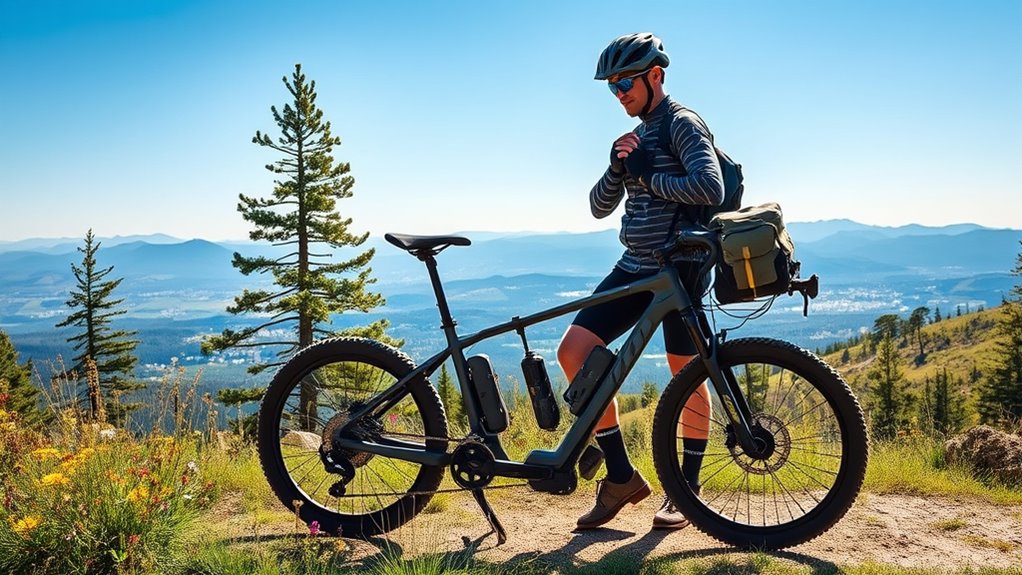
Choosing the right e-bike for long-distance travel is crucial to ensuring a smooth and enjoyable journey. Start by considering motor selection; a mid-drive motor offers better efficiency and power, especially on hills, while a hub motor can provide a simpler, lower-maintenance option. Think about your terrain and riding style when choosing. Tire considerations are equally important—look for wider tires with puncture-resistant tread to handle varied surfaces and reduce flats. Quality tires improve comfort and stability over long distances. Make certain your e-bike’s motor provides enough assist without draining the battery too quickly, and select tires suited for your typical routes. Proper tire selection can significantly impact your riding experience by enhancing safety and comfort over diverse terrains. Making these choices carefully helps you maintain comfort, efficiency, and reliability throughout your cross-country adventure.
Essential Gear and Packing Tips for Extended Rides
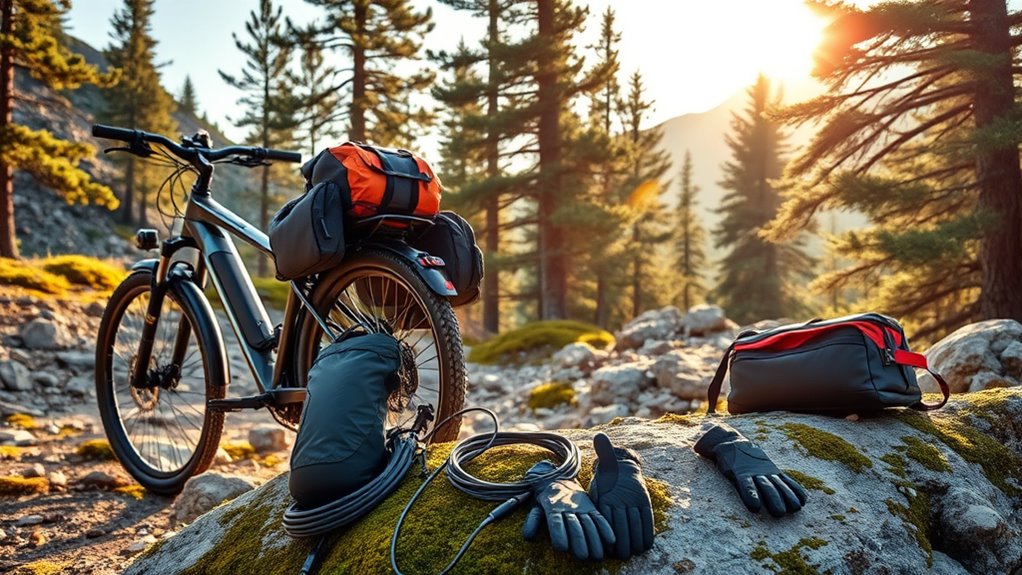
Beginning on extended e-bike rides requires careful planning to guarantee you have all essential gear within reach. Effective storage solutions are key—use panniers, handlebar bags, or backpacks to organize your gear efficiently. Prioritize waterproof and weather-resistant bags to shield against rain, wind, and changing conditions. Pack lightweight, multi-purpose clothing for varying temperatures and weather protection, including a compact rain jacket and warm layers. Don’t forget essential tools, a first-aid kit, and spare parts like tubes and a pump. Keep electronics charged with portable power banks. Properly organized gear ensures quick access and minimizes hassle during your trip. Weather protection, in particular, helps maintain comfort and safety, so choose gear that can handle diverse conditions across your route. Staying aware of nutritional value of juices can also be beneficial if you plan to include healthy snacks or drinks during your ride.
Planning Your Route and Finding Charging Stations

Before hitting the road, you need to map out your route carefully, considering your daily distances and terrain. Make sure to locate charging stations along your path so you can plan for quick top-ups. Don’t forget to schedule rest stops that give you time to recharge both your battery and yourself. Incorporating smart indoor gardens into your planning can help you grow fresh herbs and greens to stay nourished during your trip.
Mapping Your Path
Mapping your path is a crucial step in guaranteeing a smooth cross-country e-bike tour, especially when it comes to planning your route and locating charging stations. Good route planning helps you set realistic daily distances and identify scenic or interesting stops along the way. Use navigation tools like GPS devices or smartphone apps to plot your course accurately. These tools can provide real-time updates on terrain, road conditions, and elevation changes, helping you make adjustments on the fly. Take time to review your route before starting each day to avoid surprises and guarantee you stay on track. Proper mapping reduces stress, conserves battery life, and keeps you moving efficiently toward your destination. A well-mapped route is your foundation for a successful, enjoyable trip. Incorporating thorough due diligence when researching charging station locations ensures you won’t encounter unexpected power shortages and can plan charging stops strategically.
Locating Charging Spots
Once you’ve plotted your route, the next step is to identify where you’ll recharge along the way. Start by exploring charging networks that cover your planned route; many providers offer extensive coverage for long-distance trips. Use station locators to find nearby charging stations quickly and efficiently. These tools help you pinpoint station locations, check availability, and determine charging types compatible with your e-bike. Planning your stops in advance ensures you won’t run out of power unexpectedly. Keep in mind that some networks require memberships or apps, so set those up beforehand. By mapping out your charging spots along your route, you can maintain momentum and reduce travel stress, making your cross-country adventure smoother and more enjoyable. Additionally, understanding the role of high-quality chargers can help you optimize your charging time and efficiency during your journey.
Planning Rest Stops
Planning your rest stops is essential for a smooth cross-country e-bike tour, as it guarantees you recharge both your batteries and your energy levels. To optimize your journey, map out charging stations along your route, especially near hydration stations and scenic vistas. This ensures you stay refreshed and motivated, with beautiful views to enjoy during breaks. When planning, consider these tips:
- Identify hydration stations for quick water refills and snacks
- Schedule stops at scenic vistas to rest and take photos
- Use apps to locate nearby charging spots and rest areas
- Incorporate knowledge about juice detox to understand how proper hydration and nutrition can enhance your energy and overall well-being during long rides.
Balancing charging needs with scenic breaks keeps your trip enjoyable and sustainable. Proper planning minimizes surprises and helps you stay energized, making your long-distance adventure more rewarding.
Battery Management and Power Conservation Strategies

To make your battery last longer on your journey, you need to focus on optimizing its life and using power wisely. Simple techniques like riding at steady speeds and avoiding sudden stops can markedly extend your range. By mastering smart power usage, you’ll guarantee your e-bike is ready when you need it most. Additionally, monitoring your battery health helps prevent unexpected power loss and maintains your bike’s performance over time.
Battery Life Optimization
Effective battery management is essential for extending your e-bike’s range during long-distance touring. To optimize battery life, focus on maintaining your battery capacity and using advanced charging technology. Properly charging your battery—avoiding overcharging and using fast chargers—preserves its lifespan. Additionally, monitor your battery’s health regularly and store it in a cool, dry place when not in use. You can also extend range by adopting these strategies:
- Use energy-efficient riding modes and avoid sudden accelerations
- Keep tires properly inflated to reduce rolling resistance
- Minimize unnecessary electrical accessories when not needed
- Regularly check the battery’s connection to ensure optimal power transfer and prevent potential issues.
Smart Power Usage Techniques
Smart power usage techniques are essential for maximizing your e-bike’s battery life during long-distance touring. To do this, focus on eco-friendly charging by using renewable energy sources or solar chargers when possible. Additionally, reduce power drain by choosing energy-efficient accessories, like LED lights and low-draw displays. Maintain steady riding by avoiding sudden accelerations and braking, which waste energy. Keep your tires properly inflated to reduce rolling resistance and conserve power. Use the bike’s regenerative braking system if available, to recover energy during descents. Plan your routes to avoid steep climbs and heavy traffic, which can drain your battery faster. Being aware of your sensor systems can help you monitor and optimize your power consumption effectively. By adopting these strategies, you’ll extend your battery’s lifespan and enjoy a more sustainable, efficient touring experience.
Preparing Your Body and Mind for the Journey
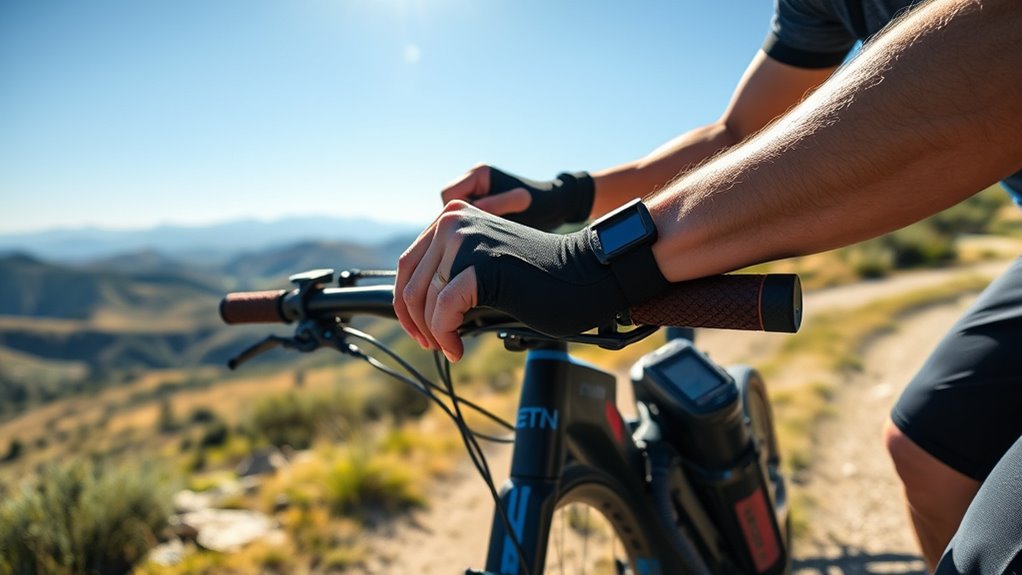
Preparing your body and mind for a cross-country e-bike tour requires intentional effort and planning. Building mental resilience helps you stay motivated during tough stretches, while increasing physical endurance ensures you can handle long days in the saddle. To get ready, focus on gradually increasing your riding distance, incorporating strength and flexibility exercises, and practicing mindfulness to boost mental clarity. Additionally, understanding fan culture can enhance your experience by connecting you with a community of enthusiasts who share your passion for cycling and adventure. You can also:
- Maintain a balanced diet to fuel your rides
- Prioritize sleep and recovery to prevent fatigue
- Visualize successful trips to strengthen confidence
Safety Precautions and Emergency Preparedness
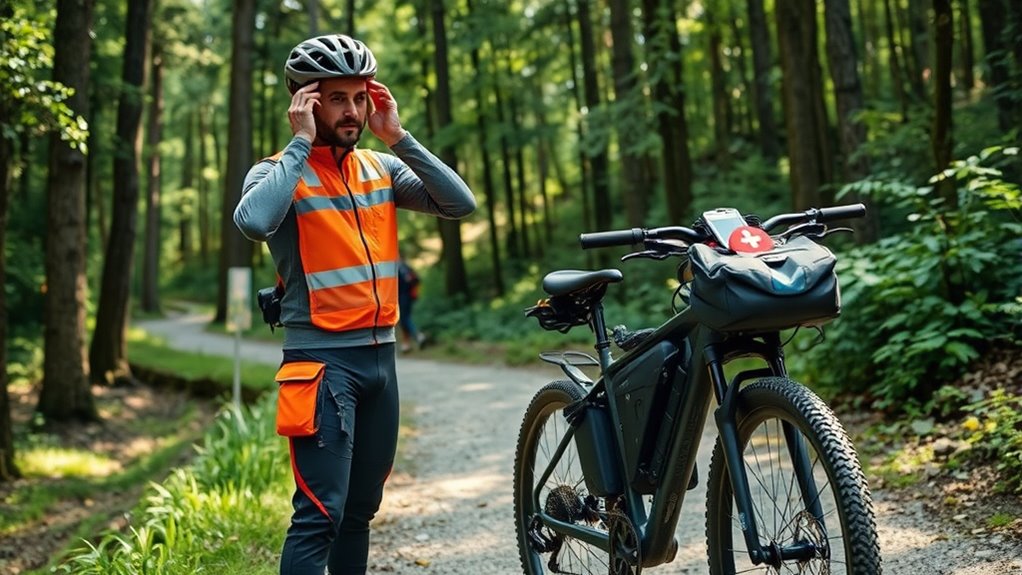
As you gear up for a cross-country e-bike tour, prioritizing safety and emergency preparedness can make all the difference in handling unexpected situations. Always carry essential safety gear like helmets, reflective clothing, and lights to protect yourself and stay visible. Guarantee your personal safety by planning routes that avoid high-traffic areas and hazardous terrain. Keep a list of emergency contacts easily accessible—share it with someone you trust and include local emergency services. Carry a fully charged phone, portable charger, and a basic first aid kit. Familiarize yourself with basic first aid procedures and local emergency protocols. Being prepared reduces risks and helps you respond swiftly if an emergency arises, giving you peace of mind throughout your journey. Incorporating real-time analytics into your planning can help you stay updated on weather conditions and route safety, further enhancing your trip’s security.
Maintenance and Troubleshooting on the Road
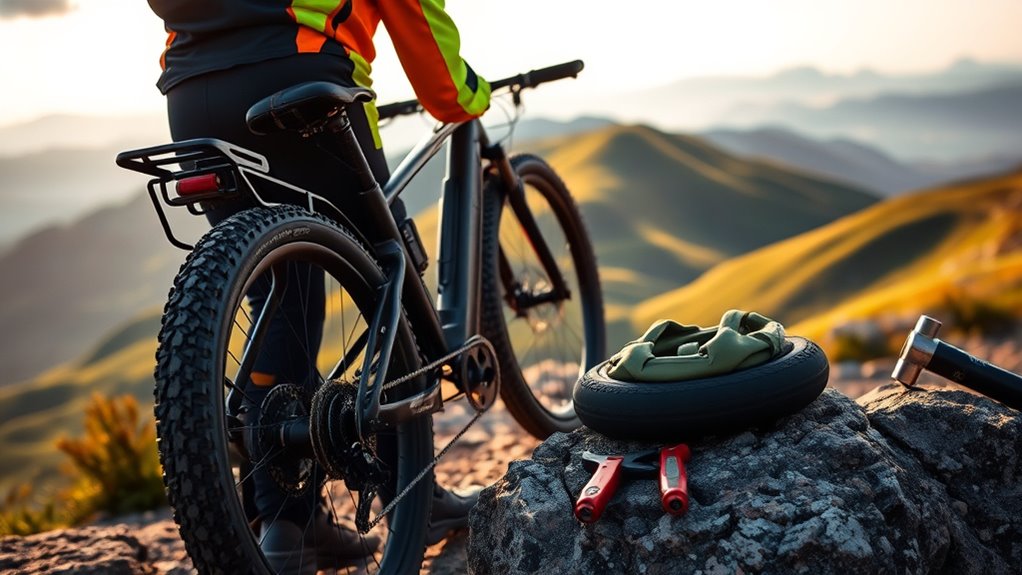
Regular maintenance and quick troubleshooting are essential to keep your e-bike running smoothly during your cross-country tour. Being prepared means you can handle common issues like flat tires or chain problems efficiently. Carry a basic repair kit that includes tire patches, a pump, and a multi-tool. You should also regularly check and lubricate your chain to prevent rust and ensure smooth pedaling. When facing a flat tire, swiftly perform a tire repair by removing the tube and patching the hole. For chain issues, apply chain lubrication to reduce wear and noise. Keep an eye on tire pressure and listen for unusual sounds from your chain or motor. Staying proactive with these simple tasks helps you avoid breakdowns and keeps your ride enjoyable. Additionally, understanding tuning options for your e-bike can help optimize performance and address minor mechanical issues before they become major problems.
Frequently Asked Questions
How Do I Choose a Bike Suitable for Different Terrains?
When choosing a bike suitable for different terrains, you need to think about your bike frame and tire types. Opt for a sturdy, versatile frame like aluminum or carbon for durability and comfort. Select tire types based on terrain; knobby tires work well for off-road, while slicks suit pavement. Think about your riding style and conditions, and pick a bike that balances strength, flexibility, and the right tires to handle diverse terrains effectively.
What Legal Considerations Apply to Cross-Country E-Bike Touring?
When planning your cross-country e-bike tour, you need to take into account legal factors like insurance requirements and licensing regulations. You might be required to have specific insurance coverage, especially if you plan to ride on public roads. Licensing laws vary by region, so check local rules to ensure your e-bike complies. Staying informed helps you avoid fines and legal issues, making your trip smoother and more enjoyable.
How Can I Find Reliable Wi-Fi or Internet Access During My Trip?
Did you know that over 80% of travelers find Wi-Fi hotspots and mobile data plans essential for staying connected? To find reliable internet access, carry a portable Wi-Fi hotspot or check local Wi-Fi hotspots in cafes, libraries, and public spaces. Consider investing in a global mobile data plan to guarantee consistent coverage across different regions. This way, you stay connected without interruptions during your long-distance trip.
What Are the Best Methods for Securing My E-Bike Overnight?
When securing your e-bike overnight, choose sturdy bike lock options like U-locks or heavy-duty chain locks to deter theft. Always lock your bike to an immovable, secure object, and consider removing the battery if possible. Follow security tips such as hiding accessories, taking photos of your bike, and avoiding obvious locations. These steps help protect your bike and give you peace of mind during overnight stays.
How Do I Handle Language Barriers or Communicate in Remote Areas?
Exploring the linguistic landscape is like decoding a silent symphony of cultural differences. You can bridge gaps by observing non-verbal cues, like gestures or facial expressions, which speak volumes beyond words. Carry a translation app or phrasebook to act as your linguistic compass. Patience and a genuine smile often serve as universal language, transforming potential barriers into bridges that connect hearts across diverse terrains.
Conclusion
Even if you’re worried about the challenges of long-distance e-bike touring, proper preparation makes it manageable and enjoyable. With the right gear, route planning, and mindset, you’ll find yourself exploring new places and gaining confidence along the way. Remember, every journey has its hurdles, but they’re worth overcoming. Embrace the adventure, stay flexible, and you’ll discover that the thrill of the ride surpasses any initial doubts.
